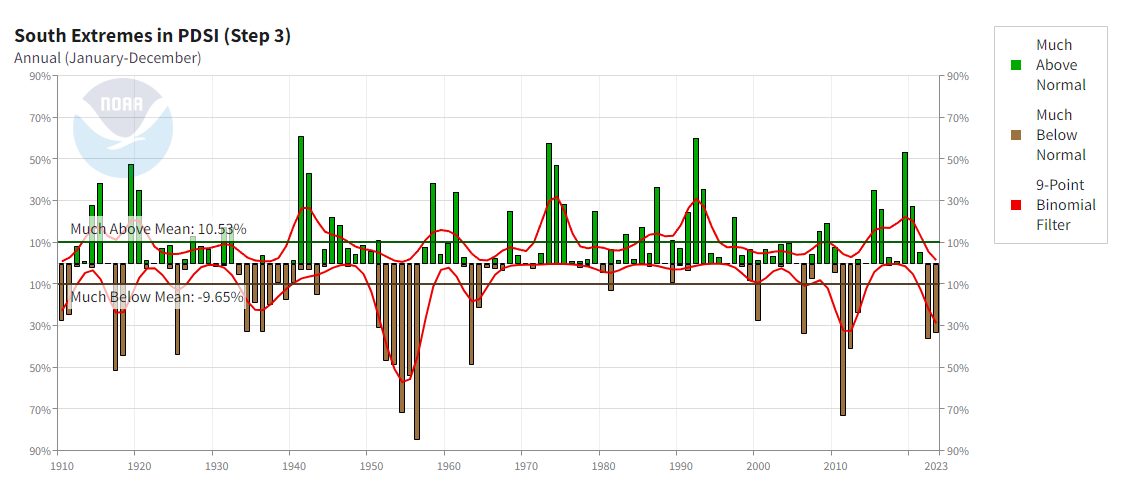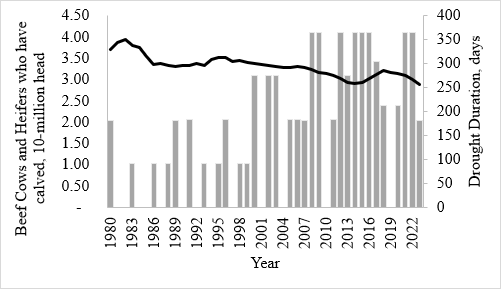Cow-Calf Corner | July 15, 2024
Cattle and Beef Markets in the Summer Doldrums
Derrell S. Peel, Oklahoma State University Extension Livestock Marketing Specialist
Here in Oklahoma and a lot of other parts of the country we have reached the dog days of summer. That was once described to me as a hot summer day when “a dog is chasing a cat down the street…and they are both walking”. Cattle and beef markets often struggle in the period after July 4 until mid-August or so. The week after Independence Day, Choice boxed beef prices dropped back from holiday highs of $330/cwt. to about $322/cwt. but seemed to stabilize by the end of the second week of July.
Beef demand usually slows between the July 4 and Labor Day holidays as both summer grilling and high-end restaurant traffic slows in the heat of the summer. The early July drop in boxed beef price is the result of seasonal weakness in the main middle meats: Tenderloin, Ribeye and Strip Loin. Wholesale prices for a number of other cuts continue to move higher, including Tri-tip and Flank steak, along with numerous chuck and round cuts. Several lean round cuts are no doubt supported by the record high price for lean trimmings that is pushing wholesale ground beef value to ever-higher record levels.
Fed cattle prices have stalled in the summer heat in July, holding mostly steady after moving higher through June. Carcass weights finally showed some decrease with the latest reported steer carcass weights the last week of June at 911 pounds, down from 924 pounds five weeks earlier. Summer heat is likely a factor in declining carcass weights as well. The decrease in carcass weights has been much slower than is typical through June and it is not clear what the seasonal pattern will be for the remainder of the year. Carcass weights typically begin increasing seasonally in July but steer carcasses are already 27 pounds higher year over year, even with the recent decrease.
Total fed (steer plus heifer) slaughter was fractionally higher in June year over year and, combined with heavier carcass weights, led to a 3.8 percent year over year in fed beef production for the month. This more than offset a 17.1 percent year over year decrease in nonfed beef production to result in a slight increase in total beef production in the month of June. Retail all-fresh beef prices in June continued to move slightly higher to a record price of $8.00/lb.
Feeder cattle markets also stalled after July 4, with lower prices for all classes reported in Oklahoma auctions for the week ending July 12. Nevertheless, feeder cattle prices remain near record levels. Although June rains have maintained pastures reasonably well thus far, marginal drought conditions have increased in Oklahoma with range and pasture ratings slipping in the latest ratings report.
Dr. Derrell Peel, OSU Extension livestock marketing specialist, explains why beef production is not slowing down as quickly as expected on SunUpTV from July 13, 2024.
The Asian Longhorned Tick
Mark Z. Johnson, Oklahoma State University Extension Beef Cattle Breeding Specialist
Asian longhorned ticks (Haemaphysalis longicornis) are invasive pests that pose a serious threat to cattle in the United States. They can form large infestations on one animal and spread diseases that impact both animals and humans alike. This species of tick is native to East Asia, including China, Japan, the Russian Far East and Korea. Asian longhorned ticks (ALHT) are not normally found in the western hemisphere but have become a concern since 2017, when public health officials in New Jersey reported the first detection of the ALHT outside of a U.S. port of entry inspection site. Since that time, the ALHT has spread to 19 states including: Arkansas, Connecticut, Delaware, Georgia, Indiana, Kentucky, Maryland, Massachusetts, Missouri, New Jersey, New York, North Carolina, Ohio, Pennsylvania, Rhode Island, South Carolina, Tennessee, Virginia, and West Virginia.
The ALHT has the unique ability to reproduce quickly and in large numbers. Unlike other tick species, the ALHT is parthenogenetic, meaning an individual female they can lay eggs without mating, essentially cloning herself to create the next generation. This allows few individual female ALHT to establish large populations very quickly. This is one reason the ALHT is a successful invader of new geographic regions. In addition, they have been found to infest a wide range of hosts, including mammals, birds, and reptiles, which further increases their potential impact. As well, there are no known natural predators to the ALHT in the United States, which also contributes to their ability to spread into new areas.
One of the main concerns with the ALHT is their ability to transmit diseases. While there have been no reports of ALHT transmitting disease to humans in the United States, they have been found to be infected with several pathogens. Asian longhorned ticks in the United States successfully transmitted Theileria orientalis Ikeda to cattle in the laboratory. This pathogen has also been detected in field-collected ALHT. Clinical signs of theileriosis are similar to anaplasmosis in cattle and include anemia, jaundice, and weakness. Therefore, there is a potential risk for disease transmission if these ticks are not properly managed.
While the risk of disease transmission from ALHT to humans in the United States is currently low, their potential to establish populations and transmit diseases makes them a concern. Proper management and control measures, such as tick checks, pesticide treatments, and removal of potential tick habitats, can help reduce the risk of exposure to these ticks and the diseases they may carry. It is important to be aware of the potential risks and take precautions to protect yourself and your cattle. The ALHT may be introduced to new areas through the movement of host animals, contaminated clothing or equipment, or other means of transport. Once introduced, these ticks can quickly establish populations and become a nuisance. Methods of tick control are addressed in the third USDA reference below.
References
- Asian Longhorned Ticks
- Emerging Risk Notice
- Monitoring Haemaphysalis longicornis, the Asian longhorned tick, populations in the United States
- Dr. Justin Talley has information about the Asian Longhorned tick and Dr. Barry Whitworth explains how it impacts livestock from SunUpTV from June 6, 2020.
Increasing the Resilience of the Beef Cattle Supply: 1. Impact of Drought on Cattle Numbers
Paul Beck, Oklahoma State University State Beef Cattle Nutrition Specialist
The articles for this and upcoming weeks are based on the thoughts that I put together for a symposium at the American Society of Animal Science meeting held in Calgary “Increasing the Resilience of the Beef Cattle Feeder Supply”.
It seems like the climate cycles have turned against us. Figure 1 shows the NOAA extremes in Palmer Drought Severity Index (PDSI) from 1910 to 2023. Since the early 2000’s droughts have become more frequent and more severe than any time since the 1950’s. In the era from the late 1960’s to the early 2000’s, we had been in a long-term wet cycle, one that appears to be abnormal compared to our historical climate since 1910. The environmental conditions from 1970 to 2000 is the only thing many of us ever knew. This 30-year span also corresponds to the evolution of our modern beef cattle production system. Leading to the question, would the production practices we developed from 1970 to 2000 be sustainable in the 1950’s and 60’s? If we are returning to that weather pattern, will they be sustainable in the future?
Along with the increasing severity and frequency of droughts, other weather-related events have become more common and more costly. Extremes in heat during the summer and winter storms in the winter, 1,000-year floods, out of control fires, and other disasters have become more frequent impacting human life and agricultural productivity.
Droughts impact cattle numbers and drive the timing of the expansions and contractions of the cattle cycle. Below the numbers of beef cows and heifers that have calved (black line) is super imposed on the drought duration (gray bars) in each year. Widespread drought in 2011 through 2013 resulted in a 2.5% decrease in beef cattle herd size, resulting in record high prices stemming from the low cattle numbers. This gave the impetus for a nearly 3.5% increase in the beef cattle herd by 2018 when conditions returned to normal. Then in 2021, a return of drought conditions, yet again resulted in a 2.5% decrease in the beef cattle herd through 2023.
The USDA estimates there is currently 17.1 million head one-time capacity in feedlots, so based on 1.9 turns per year in the feedlot (current average is 192 days on feed), 80% occupancy rates, normal heifer retention of 3.5 million head per year, normal imports of feeder calves from Mexico (1 million head) and Canada (150,000 head), and 77% weaning rate (based on 81.4% calving rate and 95% calf survival rate), we need 32.3 million beef cows to supply the feedlots each year. We almost reached that in 2019 (31.8 million beef cows) but the U.S. beef cow herd is currently at 28.2 million head. The shortage of feeder cattle will result in changes in production practices (longer days on feed, reduced weights of feeders entering the feedlot, etc) and increased bids for feeder cattle, but there are other implications of drought that we will cover next week.


